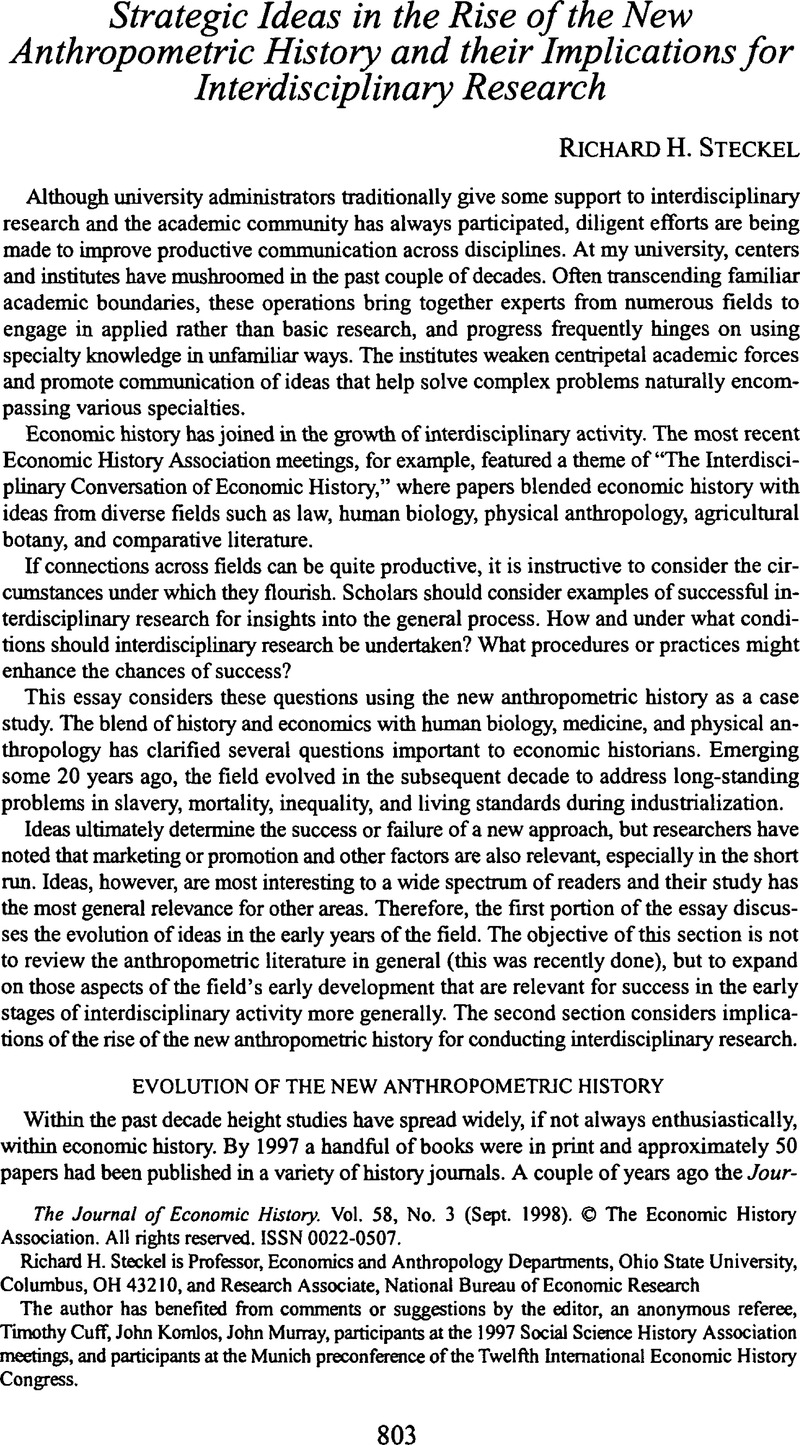Crossref Citations
This article has been cited by the following publications. This list is generated based on data provided by Crossref.
Heyberger, Laurent
2003.
Estimer la stature des Alsaciens (1780-1794).
Histoire & mesure,
Vol. XVIII,
Issue. 1/2,
p.
73.
Steckel, Richard H.
2004.
New Light on the “Dark Ages”.
Social Science History,
Vol. 28,
Issue. 2,
p.
211.
Federico, Giovanni
2004.
Vol. 22,
Issue. ,
p.
125.
Steckel, Richard H.
2005.
Health and Nutrition in Pre-Columbian America: The Skeletal Evidence.
The Journal of Interdisciplinary History,
Vol. 36,
Issue. 1,
p.
1.
Salvatore, Ricardo D.
2007.
Heights, Nutrition, and Well-Being in Argentina, ca. 1850–1950. Preliminary Results.
Revista de Historia Económica / Journal of Iberian and Latin American Economic History,
Vol. 25,
Issue. 1,
p.
53.
Steckel, Richard H.
2008.
The New Palgrave Dictionary of Economics.
p.
1.
Steckel, Richard H.
2009.
Heights and human welfare: Recent developments and new directions.
Explorations in Economic History,
Vol. 46,
Issue. 1,
p.
1.
Padez, Cristina
Varela‐Silva, Maria Inês
and
Bogin, Barry
2009.
Height and relative leg length as indicators of the quality of the environment among Mozambican juveniles and adolescents.
American Journal of Human Biology,
Vol. 21,
Issue. 2,
p.
200.
Djedid, Karim
and
Hau, Michel
2009.
Stature et malnutrition dans l'Alsace de la première moitié du XIXe siècle.
Histoire, économie & société,
Vol. 28e année,
Issue. 1,
p.
35.
Inwood, Kris
and
Roberts, Evan
2010.
LONGITUDINAL STUDIES OF HUMAN GROWTH AND HEALTH: A REVIEW OF RECENT HISTORICAL RESEARCH.
Journal of Economic Surveys,
Vol. 24,
Issue. 5,
p.
801.
Inwood, Kris
and
Roberts, Evan
2011.
Economics and History.
p.
47.
Heyberger, Laurent
2012.
Handbook of Anthropometry.
p.
253.
Komlos, John
2012.
A Three-Decade 'Kuhnian' History of the Antebellum Puzzle: Explaining the Shrinking of the US Population at the Onset of Modern Economic Growth.
SSRN Electronic Journal,
Steckel, Richard H.
2012.
Human Growth and Development.
p.
225.
Campos-Vázquez, Raymundo M.
and
Vélez-Grajales, Roberto
2012.
Did Population Well-being Improve During Porfirian Mexico? A Regional Analysis using a Quasi-Human Development Index.
Journal of Human Development and Capabilities,
Vol. 13,
Issue. 4,
p.
597.
Bodenhorn, Howard
Guinnane, Timothy W.
and
Mroz, Thomas A.
2013.
Problems of Sample-Selection Bias in the Historical Heights Literature: A Theoretical and Econometric Analysis.
SSRN Electronic Journal,
Steckel, Richard H.
2013.
Biological Measures of Economic History.
Annual Review of Economics,
Vol. 5,
Issue. 1,
p.
401.
Coclanis, Peter A.
2013.
Pitirim A. Sorokin's early contributions to the development of anthropometric history.
Economics & Human Biology,
Vol. 11,
Issue. 3,
p.
259.
Heyberger, Laurent
2014.
Received wisdom versus reality: height, nutrition, and urbanization in mid-nineteenth-century France.
Cliometrica,
Vol. 8,
Issue. 1,
p.
115.
Heyberger, Laurent
2014.
Les Parisiens et les banlieusards étaient-ils aussi grands que cela ? Stature, nutrition et urbanisation en France au milieu du xix e siècle.
Annales de démographie historique,
Vol. n° 126,
Issue. 2,
p.
113.



